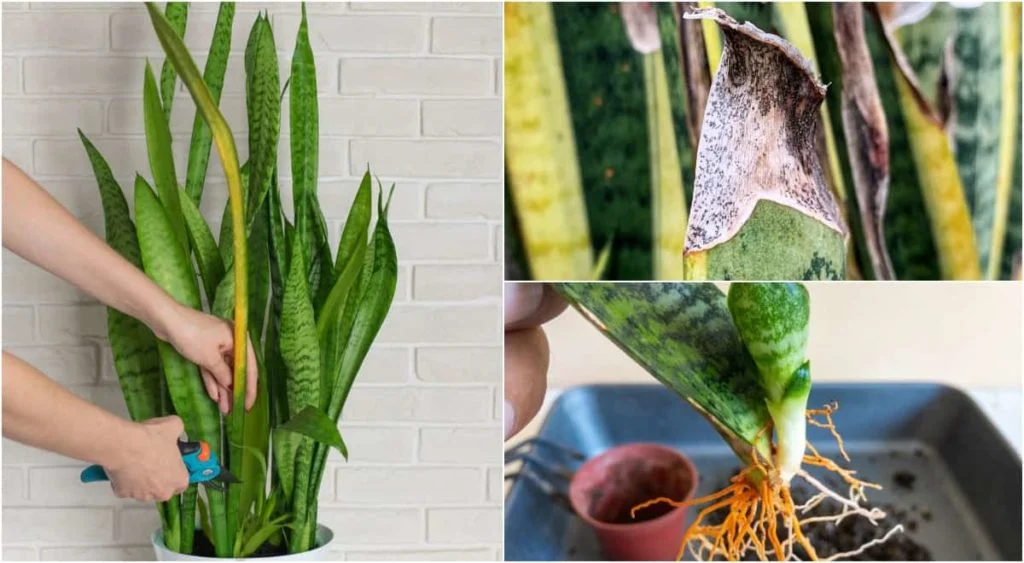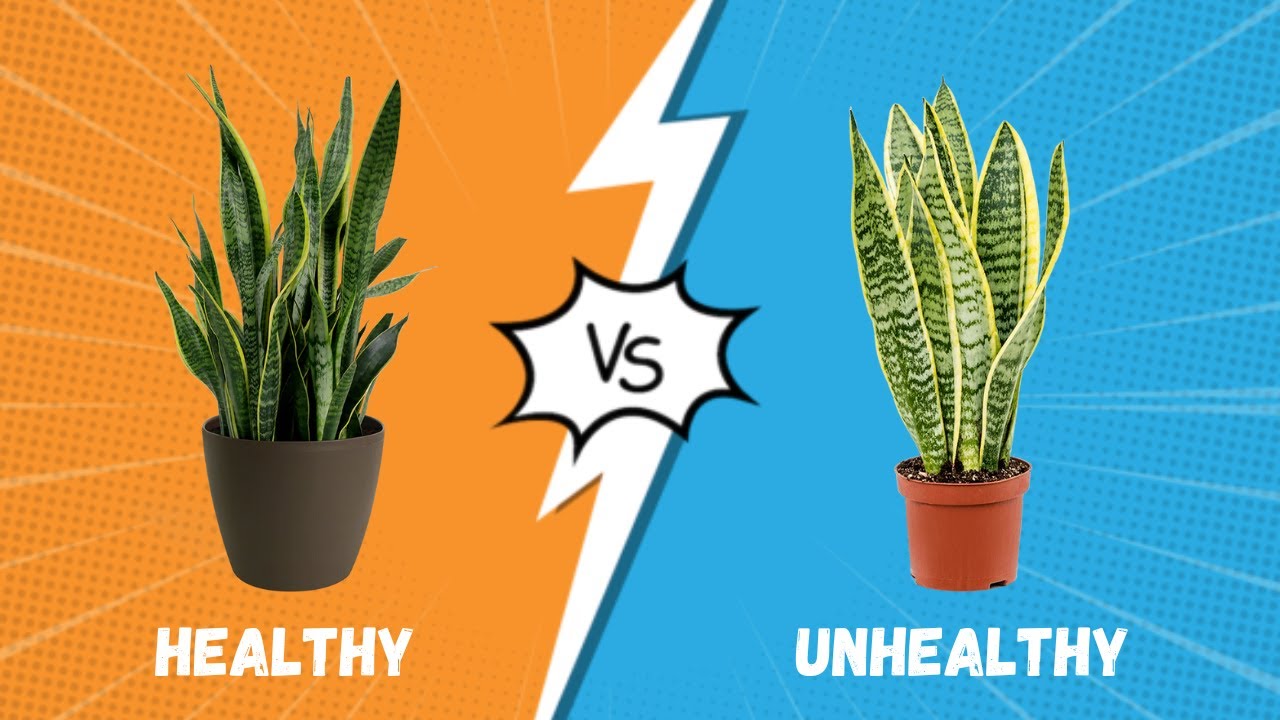Snake plant roots tell a clear story about your plant’s health and survival chances. These popular houseplants need minimal care but depend on healthy roots to thrive. Strong snake plant roots should feel firm with white to orange coloring and give off a fresh, earthy smell. These qualities help the plant grow well and make it easy to maintain.
Bad root health shows obvious warning signs that plant owners need to spot quickly. When roots turn brown or black and feel mushy with a bad smell, root rot has likely set in. This fungal problem stops your plant’s water and nutrient flow. Most root rot happens because of too much water or drainage problems, even though snake plants know how to survive weeks without water. Your plant’s roots should look creamy white to light tan and feel firm with slight moisture. Knowing these signs lets you catch problems early enough to save the plant. This piece shows the differences between good and bad snake plant roots and gives you applicable information to spot issues, fix them, and keep your plant healthy.

Table of Contents
- 1 What Do Healthy Snake Plant Roots Look Like?
- 2 How to Identify Unhealthy Snake Plant Roots
- 3 Top Causes of Root Problems in Snake Plants
- 4 How to Fix Unhealthy Roots and Save Your Plant
- 5 Tips to Keep Snake Plant Roots Healthy Long-Term
- 6 Summing all up
- 7 Here are some FAQs about healthy snake plant roots vs unhealthy:
What Do Healthy Snake Plant Roots Look Like?
You need to know what healthy snake plant roots look like to take good care of your plant. This knowledge helps you spot problems early and saves time and effort down the road.
Color and texture of healthy roots
Thriving snake plant roots show colors from creamy white to light tan, and newer roots tend to be lighter. The rhizomes (specialized underground stems) have a bright orange or yellowish color that’s normal and shows good health. This orange shade comes from extra carotene stored in the roots.
Healthy roots have a smooth surface without soft spots or slime. They look clean and well-formed with no damage. Snake plant roots stand out from other houseplants because they adapted to desert conditions. The roots also keep the same color throughout their structure.
Firmness and moisture levels
A healthy snake plant’s roots feel firm and slightly plump. They shouldn’t be mushy, slimy, or too brittle since these textures point to problems. The roots should stay slightly moist but never waterlogged.
You can check firmness by squeezing the roots gently between your fingers. They should resist pressure instead of collapsing. Roots that are too dry and brittle or too soft and yielding show problems that need attention. Root firmness affects how well the plant absorbs water and nutrients.
Smell and appearance of rhizomes
Rhizomes play a key role in the snake plant’s root system. These thick, horizontal stems grow underground and store energy and water. You’ll find healthy rhizomes are bright orange and firm. They also act as growth points where new roots and leaf shoots emerge.
A healthy root system has a neutral, earthy smell. Any sour, rotten, or bad odor means you might have root rot or other issues. Rhizomes might smell a bit earthier than the fibrous roots, but they should never have an unpleasant odor.
Growth pattern in the pot
Snake plants develop root systems that spread evenly in the pot. Their roots stay fairly shallow, with most growing near the soil surface. The plant prefers to send new rhizomes outward instead of downward, which makes it easier to propagate and spread.
Signs of healthy growth include:
- Even spread throughout the growing medium
- Medium density without too much compaction
- No tight coiling at the pot’s bottom
- Few roots coming out of drainage holes
Snake plants can handle being somewhat root-bound, but cramped roots make it hard to absorb water and nutrients. You might need to repot if roots circle the pot’s edge or pop out of drainage holes.
These visual and physical traits of healthy snake plant roots are a great way to get insights for keeping these popular houseplants. Regular checks during repotting or propagation help ensure your snake plant keeps a reliable root system that supports the best growth.

How to Identify Unhealthy Snake Plant Roots
Snake plants need early problem detection to avoid permanent damage. These plants are tricky because they hide their root problems until things get really bad. That’s why checking them regularly is vital for keeping them alive.
Signs of root rot
Root rot shows up above ground before you can see what’s happening underneath. The original signs might be yellow or wilting leaves even when you’re taking good care of the plant. Your plant’s leaves will feel soft and mushy if you give them a gentle squeeze – that’s a clear sign there’s too much water inside. The soil also has a mildew-like smell.
A single yellow leaf needs your attention because it often points to problems under the surface. Your plant might grow slower because its damaged roots can’t take in nutrients properly. These signs could mean different things, so the quickest way to know if it’s root rot is to look at the roots directly.
Discoloration and mushy texture
Healthy roots should be white and firm, but unhealthy ones look completely different. Rotting roots turn brown or black. In bad cases, they feel mushy like in overcooked spaghetti.
The biggest difference is how they feel. Normal snake plant roots can be dark sometimes, but they stay firm when you touch them. Bad roots fall off the plant easily and break with just a light touch. This happens because fungi like Pythium or Rhizoctonia start breaking down the root tissue.
Foul smell and slimy feel
The smell is probably the clearest sign that roots aren’t healthy. Rotting roots smell terrible, like something that’s decomposing. Bacteria breaking down the dying roots cause this nasty smell.
Bad roots also get slimy and feel slippery between your fingers. This slime means the roots have decayed so much that their structure is gone. The roots stop working at this point, and even though the plant sits in wet soil, it can’t get water or food – it’s basically starving.
Root-bound or compacted roots
Snake plants can have root problems even without rot if they’re too cramped. Root-bound plants show clear signs: roots circle inside the pot, stick out through drainage holes, or sometimes break their containers.
Soil in these pots dries out super fast – sometimes just hours after watering. There’s another reason for this – roots take up so much space that there’s hardly any soil left to hold water. The drainage holes often get blocked by too many roots, which ironically leads to water pooling and more rot risk.
Root-bound plants show yellow leaves and keep wilting even with regular watering. Plants look thirsty all the time because their packed roots can’t take in water properly. Really bad cases lead to plants that barely grow because they’re struggling in their tight space.
Regular root checks throughout your snake plant’s life can prevent these problems from killing it. Take your plant out of its pot every few months to learn about its root system’s health. This helps you fix problems before they spread through the whole plant.
Top Causes of Root Problems in Snake Plants
Snake plant roots often suffer from problems caused by well-meaning but incorrect care. Plant owners can keep their root systems healthy and avoid getting pricey replacements by knowing these common mistakes.
Overwatering and poor drainage
Overwatering is the biggest problem that leads to unhealthy snake plant roots. These drought-resistant succulents store water in their thick leaves, which makes them easy to overwater. Too much water depletes oxygen around the roots and creates perfect conditions for hundreds of species of soil-borne bacteria and fungi to thrive. Wet soil becomes a breeding ground for fungi like Fusarium, Phytophthora, Pythium, and Rhizoctonia that attack the root system.
Even plant experts sometimes overwater their plants, especially when dealing with winter months or low-light conditions. Snake plants can die quickly when cold temperatures mix with wet soil.
Wrong soil type
Most store-bought potting mixes don’t drain well enough for snake plants. This includes mixes labeled as “succulent soil mix” or “cactus mix”. Regular potting soil holds too much water and creates soggy conditions that rot the roots.
Snake plants need:
- Well-draining, slightly acidic potting mix made for succulents
- Extra drainage materials like perlite, pumice, or coarse sand
- A mix that lets air reach the root ball
Soil gets packed down over time and doesn’t drain as well. Water can’t flow properly and air can’t circulate when soil is compacted, which raises the risk of rot. You should repot every 2-3 years with fresh, well-draining mix.
Lack of airflow in the pot
Snake plant roots must have oxygen to stay healthy. Packed, dense soil cuts off airflow around the roots, stresses the plant, and creates perfect conditions for rot.
Overcrowded roots in the pot push out soil, which leaves little medium to hold moisture properly. Water either runs through too fast or pools at the bottom—both situations hurt root health. Snake plants can handle being somewhat root-bound, but severely cramped roots struggle to absorb water and nutrients.
Using pots without drainage holes
Proper drainage might be the most important factor for snake plant root health. Roots will rot in pots without drainage holes because excess water has nowhere to go. Trapped water creates deadly conditions where roots stay constantly wet.
Your containers should have multiple drainage holes based on their size. Pots that are 36 inches need 3-4 holes, while 46-inch pots should have 4-6 holes. You should also avoid pots with attached saucers since they prevent soil from draining freely.
You can add gravel at the bottom of decorative pots without holes, but this doesn’t work as well as proper drainage holes. In spite of that, experts all agree that pots with drainage holes are your safest bet for healthy snake plant roots.
How to Fix Unhealthy Roots and Save Your Plant
Rescuing a snake plant with root problems needs quick action and a step-by-step plan. Plants with most important root damage can bounce back with the right care. These six steps give your plant the best chance to recover.
Step 1: Remove the plant from the pot
Tilt the pot sideways and ease the plant out carefully. A light watering helps loosen dry soil. Always hold the plant base—never pull the leaves because this damages both foliage and roots. Stubborn plants might need a clean knife run around the pot’s edge to free the root ball.
Step 2: Rinse and inspect the roots
Shake off extra soil and rinse the roots under running water. This vital step shows you the root system’s real condition. Healthy roots look white to tan and stay firm. Unhealthy ones turn brown to black and feel mushy. Watch out for any bad smell that signals root rot.
Step 3: Trim damaged roots
Use sterilized scissors or pruners (cleaned in nine parts water to one part bleach) and cut away all mushy black roots. Leave only firm, healthy roots behind. Be thorough—rot spreads from infected to healthy areas quickly. Cut off yellow or brown leaves too. This helps your plant save energy to heal.
Step 4: Let roots dry before repotting
The roots need several hours or overnight to dry. This creates a protective callus on cut areas and kills remaining fungal spores. Many plant experts suggest a hydrogen peroxide solution (one part 3% hydrogen peroxide to two parts water) to eliminate pathogens before drying.
Step 5: Use fresh, well-draining soil
Pick a clean pot with good drainage holes. Smaller pots work better for badly damaged plants. Fill half the pot with fresh succulent or cactus soil mix. Set the plant in place and add soil around the roots. Press gently to remove air pockets without making the soil too compact.
Step 6: Delay watering after repotting
Your newly repotted snake plant needs time before its first watering. Wait a few days while it adjusts to its new home and lets small root injuries heal. Fresh soil has enough moisture to keep your plant healthy during this significant adjustment period.
Tips to Keep Snake Plant Roots Healthy Long-Term
Snake plant roots stay healthy with a few basic principles and regular care. A proper setup and routine maintenance will keep your plant thriving for years.
Choose the right pot and soil
Snake plants grow best in terracotta or clay pots rather than plastic ones. These materials help excess moisture escape and let roots breathe better. Your pot should be wide instead of deep, with its width about double the root ball’s size.
Your snake plant’s container must have drainage holes. A 36-inch pot needs 3-4 holes, while a 46-inch one requires 4-6 holes. This design stops water from collecting at the bottom that could rot the roots.
Regular potting mix holds too much water for snake plants. You’ll need a specialized cactus or succulent mix. The best results come from this custom mixture:
- 2 parts potting soil
- 1 part perlite
- 1 part coarse sand
Water only when soil is dry
Snake plants need minimal water to thrive. Let the soil dry completely between waterings. Summer months might need watering every two weeks, but winter care requires water just once a month.
You can check watering needs by pushing your finger about 2 inches into the soil – dry soil means it’s time to water. Another trick is to lift the pot – a lightweight pot tells you the soil is dry.
Repot every 2–3 years
Snake plant soil becomes compact over time, even with excellent care. Fresh soil mix every 2-3 years keeps roots healthy. Early spring works best at the time the plant starts active growth.
Watch for roots growing through drainage holes, water draining too fast, or an unstable pot. The new pot should be just 1-2 inches bigger than the current one.
Avoid using garden soil indoors
Garden soil can harm indoor snake plants because it often has pathogens, pests, and weed seeds. Container drainage also suffers with outdoor soil.
Commercial cactus or succulent mixes give indoor snake plants the perfect balance of drainage and moisture. DIY enthusiasts should skip peat-based potting mixes since they stay too wet. The best mixes include gritty materials like pumice, perlite, or coarse sand that create air spaces roots need.
Summing all up
The difference between healthy and unhealthy snake plant roots ended up determining your plant’s life span and looks. Healthy roots are firm, white to orange, and have a fresh earthy smell. These roots create a strong foundation that helps plants thrive. Dark, mushy roots with bad odors point to serious problems that need quick attention.
Root problems don’t just happen randomly. Too much water is the main reason behind most snake plant root issues. Poor drainage, wrong soil choice, and bad air circulation make things worse. These conditions create perfect breeding grounds that let fungi and bacteria attack weak roots.
Good news is that even badly damaged plants can bounce back with the right care. Many snake plants recover from near death through careful checks, targeted cutting of damaged parts, and smart repotting methods. Quick action makes all the difference once you spot the warning signs.
It’s easier to prevent problems than fix them. Snake plant owners should start with good care habits right away. Choose the right pots with enough drainage holes. Use soil that drains well. Water only when soil dries completely. Repot every few years.
These tough plants can handle many mistakes but won’t survive long-term root stress. The best way to catch problems early is to check roots during regular care. A little effort to keep snake plant roots healthy leads to years of easy growth. These popular houseplants will reward you with their stunning looks.
Snake plants show a perfect mix of beauty and toughness. Knowing how to grow them with minimal care makes them great choices for busy people and beginners. They just need dry roots and space to grow.
Here are some FAQs about healthy snake plant roots vs unhealthy:
What are the healthy roots of a snake plant?
Healthy snake plant roots are firm, white or light tan in color, and have a slightly fuzzy texture from root hairs. When examining what do healthy snake plant roots look like, you’ll find they’re thick and succulent-like, similar to the plant’s leaves. These snake plant healthy roots should feel sturdy when gently squeezed and not break apart easily.
What do dead snake plant roots look like?
Dead snake plant roots appear dark brown or black, mushy, and often fall apart when touched. In the healthy snake plant roots vs unhealthy comparison, dead roots may also have a foul odor and slimy texture. They contrast sharply with healthy snake plant roots which remain firm and light-colored.
How to tell if plant roots are healthy?
To identify healthy snake plant roots, look for the characteristic firm, light-colored roots that hold their shape. Checking what do healthy snake plant roots look like involves ensuring they’re not brittle or mushy. Healthy roots will also show active growth with small white root hairs visible along their length.
How do I tell if my snake plant has root rot?
Signs of root rot include mushy, dark-colored roots that may smell bad – the opposite of snake plant healthy roots. When inspecting healthy snake plant roots vs unhealthy, rot will cause the roots to disintegrate easily. Above soil, yellowing leaves and stunted growth often accompany rotting healthy snake plant roots.
How can I tell if my snake plant is healthy?
A healthy snake plant has upright, firm leaves with consistent coloring and visible healthy snake plant roots when inspected. The leaves shouldn’t be wrinkled or mushy, and new growth should emerge regularly. Checking what do healthy snake plant roots look like periodically helps confirm below-ground health too.
How do I tell if I overwatered my snake plant?
Overwatering symptoms include yellowing lower leaves and soil that stays wet too long, which can lead to rotting healthy snake plant roots. The roots will turn from healthy snake plant roots to mushy, dark ones if overwatered severely. A foul odor from the soil often accompanies advanced root rot cases.

